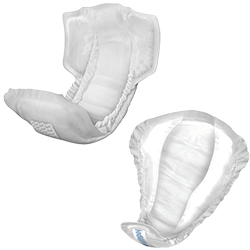Will I Experience Incontinence During My Pregnancy?

If you’re expecting a bundle of joy, you might also be worried about how pregnancy will affect your body, including bladder control. While urine leaks are often mentioned as a common occurrence after giving birth, how likely is it that you’ll experience incontinence?
Discover the most common types of urinary incontinence during pregnancy, plus tips to manage urine leaks while maintaining focus on the health of you and your baby.
Is Incontinence During Pregnancy Common?
According to the National Institutes of Health, over a third of pregnant women will experience incontinence, with stress urinary incontinence the most common type.
This means that although leaking urine during pregnancy is relatively common, over half of women don’t experience pregnancy incontinence at all.
Stress incontinence is when urine leaks occur due to pressure on the bladder — from coughing or sneezing, lifting, jogging or sometimes simply standing up from a sitting position. The amount can be a few drops or heavy enough to wet through undergarments and clothing.
Which Trimester Is Likely to Cause Incontinence?
As the baby grows, it places more weight on the bladder and internal organs, making urine leakage during the third trimester most likely.
However, The Cleveland Clinic explains that hormonal changes can cause overactive bladder and bladder leakage during pregnancy, too, so urinary incontinence in early pregnancy is also possible.
For many women, bladder leaks diminish once the baby is born, but another third of women will experience urinary or fecal incontinence after giving birth. Additional causes of incontinence during pregnancy or after childbirth include:
-
Weight gain creates extra pressure against the bladder
-
Childbirth strain weakens pelvic floor muscles
-
Tearing of muscles due to the baby, medical equipment or an episiotomy
-
Damage to the urethral or anal sphincter
Older women and those who have had multiple pregnancies are also more at risk for developing incontinence before or after childbirth.
How Can I Manage Leaking Urine While Pregnant?
Kegel exercises and other pelvic floor exercises can help fight pregnancy incontinence. Even though stress incontinence is caused by bladder pressure, strengthening the urethral sphincter can help hold in urine to prevent some accidents.
Changes in hormones due to pregnancy can also disrupt regular bowel movements. Make sure you’re eating plenty of fiber to prevent constipation, which can create even more pressure on your bladder.
If extra weight is making incontinence worse, take time during your checkup to speak with the doctor about healthful ways to trim portion sizes or other causes of weight gain.
In addition, consider keeping a bladder diary to take note of which fluids or foods might worsen incontinence. You may find that caffeinated drinks and citrus fruits trigger incontinence because they irritate the bladder, especially while expecting.
Because urine leaks are so common during pregnancy, there’s truly no need to be embarrassed if these steps don’t improve the condition. Incontinence pads can provide protection and relief in every trimester as well as after childbirth if needed.
Where Can I Find Incontinence Products to Support Me During Pregnancy?
NorthShore offers comfortable, absorbent liners and pads to support pregnant women.
These are much different from menstrual “pads." Incontinence pads are specifically designed to manage the faster flow of urine, with a special absorbent lining to lock in liquids and resist odors.
NorthShore’s DynaDry Supreme Liners are available in sizes from medium to 2X-Large so pregnant women can find the best fit for their bodies. These have a Figure 8 absorbent lining shape with absorbency between 17 and 32 ounces — with quick-wicking ability. DynaDry Supreme’s discreet, cloth-like liner also has leak guards so you can move freely without worrying about accidents. And, they can be used for both urinary and fecal incontinence.
NorthShore DynaDry Pads, Ultimate offers an hourglass absorbent lining in a small size to absorb up to 15 ounces of fluid. Instead of leak guards, these protect against leaks with four elastic bands and come in a peach color.
If more absorbency is needed, pull-up style underwear – also called protective underwear - may be a good option. They function like regular underwear and feature an absorbent lining and leak guards around leg openings for added protection. NorthShore’s GoSupreme Lite Protective Underwear is very popular with customers and offers all-day and all-night coverage if needed.

Shop AirLock Lite Briefs Briefs with tabs can also provide high-absorbency protection. They have a waterproof backing in either a plastic (poly) material or a soft cloth-like material. AirLock Lite features airflow breathability to maintain a cool and dry fit as well as promote skin health. They can be used for both day and night. Pregnant women who are bedbound or asked to limit their activities may find tab-style briefs easier to use than pull-on.
So what’s the bottom line about pregnancy incontinence? Although common, it’s not a given that you’ll experience it. If you do, manage it with exercise and comfortable products so you can focus on what matters.
If you’d like to learn more about NorthShore incontinence supplies, visit liners and pads.
Learn more about NorthShore’s selection of incontinence products for women or call our customer support team at (800) 563-0161 for personalized recommendations.
Note that this article is not a substitution for professional medical advice.
Products Mentioned in this Article
Starting at $4.99
FSA/HSA Eligible
Starting at $3.99
FSA/HSA Eligible
Starting at $7.25
FSA/HSA Eligible
Starting at $12.50
FSA/HSA Eligible












